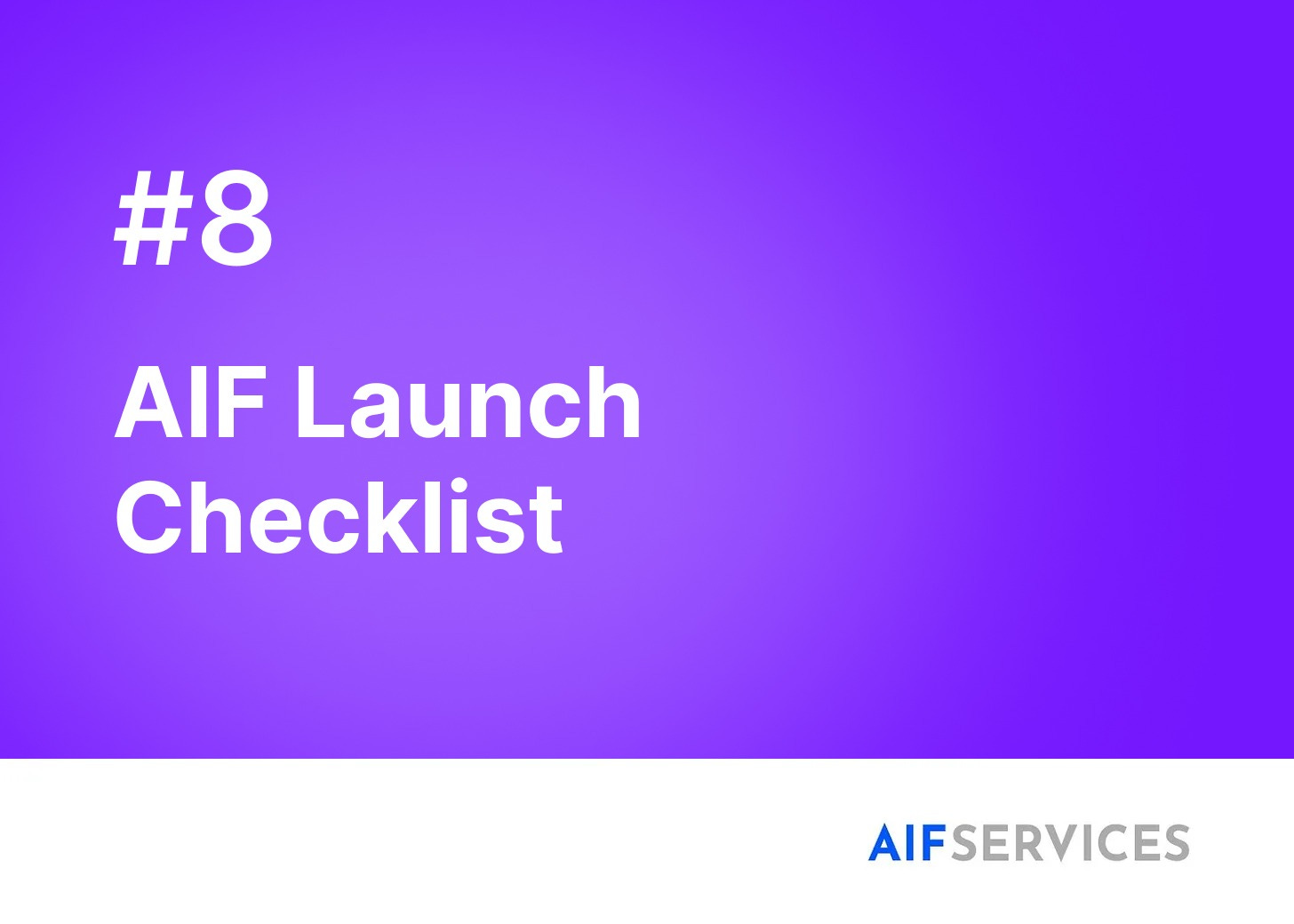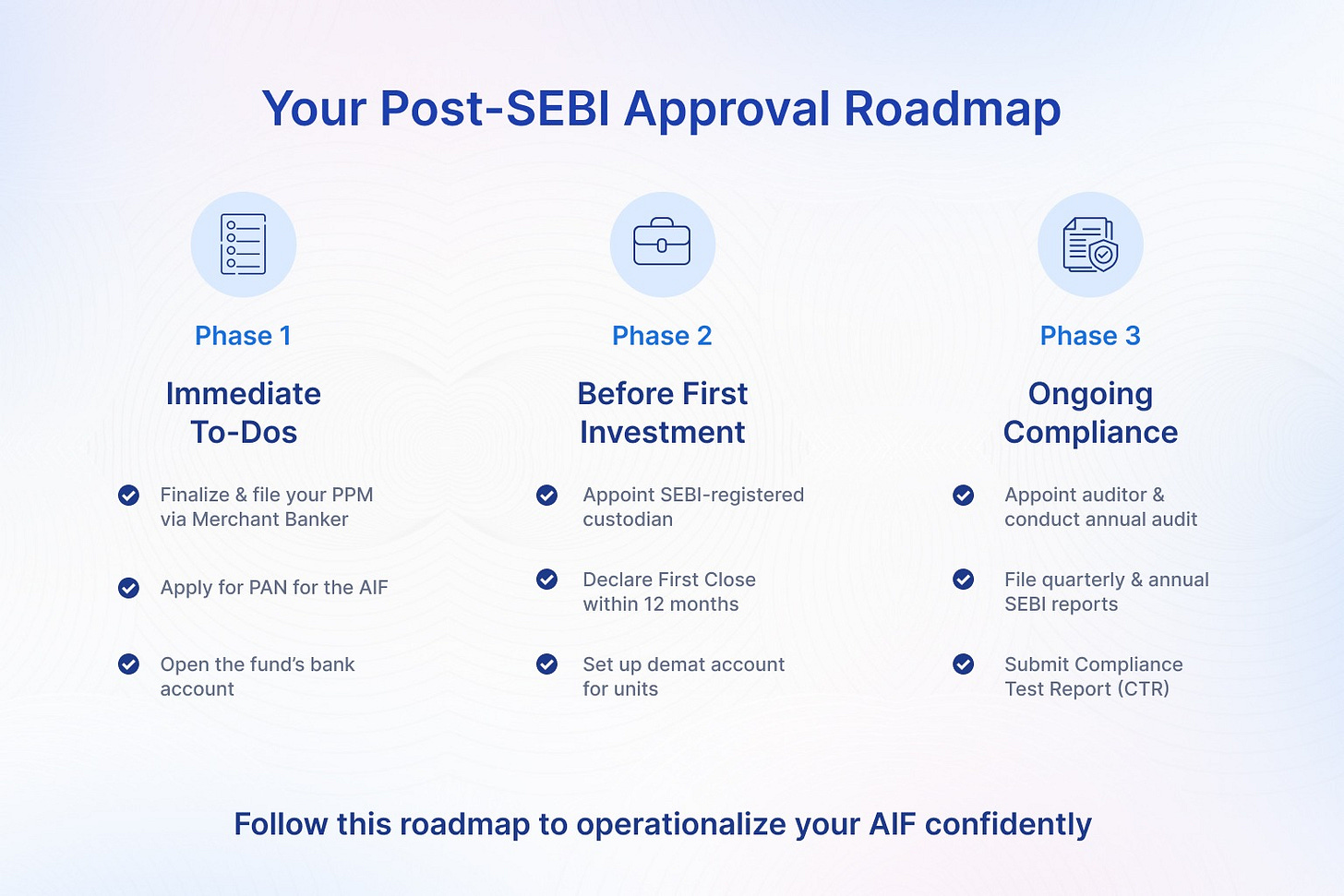Your AIF Launch Checklist
Simplifying investing from SEBI Approval to Operational Success
Congratulations on receiving your SEBI registration for your Alternative Investment Fund! This is indeed an achievement but the real work starts now that turns this license into an active, operational fund.
Think of the SEBI approval as the green light to operate as there are still a few key steps to complete before you can start accepting investments and making deals.
We’ve put together this practical checklist to guide you through the essential tasks after SEBI approval. Let’s get your fund fully operational and compliant!
Phase 1: The Immediate “Open for Business” Basics (First 30 Days)
These are the necessary steps to make your fund legally functional the right way.
Finalize and File Your PPM (Private Placement Memorandum)
You can’t accept money from investors until SEBI has the final certified version of your PPM. Get it certified by a professional Merchant Banker, as required by SEBI.
Pro Tip: Ensure your PPM clearly includes a detailed example of the fee structure and distribution waterfall. This is mandatory for compliance.Also, that your PPM reflects the latest SEBI 2025 updates, especially when your fund includes co-investment structures, accredited investors or Large Value Fund (LVF) provisions.
As per SEBI regulations, every new scheme under your AIF must file its PPM with SEBI at least 30 days before launch. This ensures transparency and early regulatory visibility.
Get the Fund’s PAN
This number is essential for every financial transaction. Without it, your fund can’t open bank accounts, make investments or handle taxes.
Apply through the NSDL or UTIITSL portal using your SEBI certificate and other fund documents.
Open the Fund’s Dedicated Bank Account
Open a bank account solely in the name of your AIF. SEBI mandates that investor funds be kept separate from the Manager’s personal or company accounts.
Provide the bank with the fund’s PAN, SEBI registration certificate and other constitutional documents.
Establish Fund Governance
Appoint a Compliance Officer, create your Investment Committee charter and establish conflict-of-interest and risk management policies. These governance documents are now expected to be maintained at the fund level.
Phase 2: Get Ready for Investment (Before the First Cheque)
Before your fund writes its first investment cheque, make sure these primary elements are in place.
Hire a Custodian
Appoint a SEBI-registered custodian to safeguard the securities your fund will purchase. This is a regulatory requirement for certain fund categories (especially Category II and III). Check whether your fund type requires a custodian as some smaller Category I or Angel Funds may be exempt depending on asset class and corpus.
The custodian will handle and safeguard the assets, such as stocks, bonds or other securities your fund purchases. They ensure that the securities are properly tracked, segregated and transferred when needed.
Announce “First Close” (Fundraising Completion)
Officially mark the end of your first round of fundraising. Declare your “First Close” once the minimum required corpus is locked in.
Do this within the timeframe stated in your scheme documents (typically within 12 months of PPM acknowledgment, though SEBI does not prescribe a fixed duration). If you miss the deadline, you will need to reapply and pay additional fees.
The “First Close” signifies that the minimum corpus required by SEBI has been secured and you can start deploying capital.
Set Up Digital Share Certificates (Demat or Equivalent)
Arrange for the issuance of units (ownership shares) in dematerialized (demat) form, as mandated by SEBI for most fund structures.
If your fund is structured as a trust or LLP, confirm the appropriate method of unit issuance such as demat units, unit certificates or ledger-based records.
Set up processes to issue units in demat form. For investors who haven’t provided their demat details, set up an “Aggregate Escrow Demat Account” to temporarily hold their units until they provide demat information.
Complete Investor Verification
Verify KYC, AML and accreditation status (if applicable). As per SEBI’s 2025 updates, only accredited investors can participate in certain fund types such as Angel Funds and Large Value Funds (LVFs).
Ensure disclosures and risk statements are signed before accepting any subscription money.
Phase 3: Stay Up with the Tasks (Ongoing Compliance)
These are ongoing tasks you’ll need to manage to stay compliant and transparent with investors.
Engage an Auditor
Hire a qualified auditor for the annual review of your fund’s finances. This is a regulatory requirement to ensure your fund remains financially healthy and compliant.
Plan Your Annual PPM Audit
Review your compliance annually to ensure you’re following the investment and fee rules laid out in your PPM. This assures both investors and SEBI that you’re sticking to your promises.
Prepare for Regulatory Reporting
You’ll need to submit required reports to SEBI (quarterly and annually) to stay in good standing with the regulator.
Include investor-level updates like portfolio summary, NAV and fee disclosures. SEBI has increased its focus on regular investor reporting and timely submission.
Your Simplified Action Tracker
Here’s a checklist to help you track your progress:
Finalize and file the PPM via a Merchant Banker (30 days before scheme launch)
Apply for the fund’s PAN
Open a dedicated Bank Account
Establish internal governance: Compliance Officer, Investment Committee and risk/conflict policies
Appoint a Custodian (where required)
Complete investor KYC, AML and accreditation verification
Announce First Close within your scheme’s defined timeline
Set up digital/demat unit issuance or equivalent ledger system
Engage an Auditor for annual financial checks
Conduct Annual PPM Audit and regular SEBI Reporting
Stay updated with SEBI’s 2025 amendments on co-investment, angel funds and accredited investors
Final Thoughts
Receiving SEBI registration is just the beginning. By following this checklist and completing each step, you’ll set a solid foundation for your fund’s successful and compliant operation.
With the 2025 updates on co-investment schemes, angel fund reforms and accredited-investor frameworks, fund managers must now operate with higher transparency, governance and investor protection.
Doing this right not only keeps you compliant but builds LP confidence and long-term credibility.
Now, let’s turn that approval into action!





